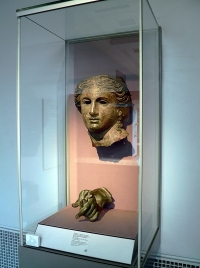Armenian Mythology
Thursday, January 11, 2024
Armenian mythology originated in ancient Indo-European traditions, specifically Proto-Armenian, and gradually incorporated Hurro-Urartian, Mesopotamian, Iranian, and Greek beliefs and deities.
The pantheon of Armenian gods, initially worshipped by Proto-Armenians, inherited their essential elements from the religious beliefs and mythologies of the Proto-Indo-Europeans and peoples of the Armenian Highlands. Historians distinguish a significant body of Indo-European language words which were used in Armenian pagan rites. The oldest cults are believed to have worshipped a creator called Ar (or possibly Ara), embodied as the sun (Arev or Areg); the ancient Armenians called themselves "children of the sun". Also among the most ancient types of Indo-European-derived worship are the cults of eagles and lions, and of the sky.
After the establishment of Iranian dominance in Armenia in the 1st millennium BCE, Zoroastrianism had a major influence on Armenian religion. Until the late Parthian period, the Armenian lands adhered to a syncretic form of Mazdaism, which mixed Iranian religious concepts with traditional Armenian beliefs. For example, the supreme god of the Armenian pantheon, Vanatur, was later replaced by Aramazd (the Parthian form of Ahura Mazda).However, the Armenian version of Aramazd preserved many native Armenian aspects. Similarly, the traditional Armenian goddess of fertility, Nar, was replaced by Anahit, which may derived from Persian Anahita, although the Armenian goddess was entirely distinct from her Iranian counterpart.
In the Hellenistic age (3rd to 1st centuries BCE), ancient Armenian deities were identified with ancient Greek deities: Aramazd with Zeus, Anahit with Artemis, Vahagn with Heracles, Astłik with Aphrodite, Nane with Athena, Mihr with Hephaestus, Tir with Apollo.
After the formal adoption of Christianity in the 4th century CE, ancient myths and beliefs transformed to adhere more closely to Christian beliefs. Biblical characters took over the functions of the archaic gods and spirits. For example, John the Baptist inherited certain features of Vahagn and Tir, and the archangel Gabriel took on elements of Vahagn.
Basic information about Armenian pagan traditions were preserved in the works of ancient Greek authors such as Plato, Herodotus, Xenophon and Strabo, Byzantine scholar Procopius of Caesarea, as well as medieval Armenian writers such as Movses Khorenatsi, Agathangelos, Eznik of Kolb, Sebeos, and Anania Shirakatsi, as well as in oral folk traditions.
The pantheon of pre-Christian Armenia changed over the centuries. Originally native Armenian in nature, the pantheon was modified through, Hurro-Urartian, Semitic, Iranian and Greek influences.
One common motif that spanned many or all pagan Armenian pantheons was the belief in a ruling triad of supreme gods, usually comprising a chief, creator god, his thunder god son, and a mother goddess.
Early Armenian
These gods are believed to have been native Armenian gods, worshipped during the earliest eras of Armenian history (Proto-Armenian). Many, if not all, of them are believed to have derived from Proto-Indo-European religion. There is also likely influence from the indigenous beliefs of the Armenian Highlands.
- Areg (Arev) or Ar, god of the Sun, comparable with Mesopotamian Utu. Likely also known as, or developed into, Ara. This god was probably mentioned on the Urartian-era Door of Meher (as Ara or Arwaa).Linguists Martin E. Huld and Birgit Anette Olsen state that the word arew is cognate to the Indian name Ravi, also meaning "sun". This etymological connection, argues H. Martirosyan, indicates an inherited Armeno-Aryan poetical expression.
- Astłik, cognate to the Mesopotamian goddess Inanna, identified with Venus. A fertility goddess and consort of Vahagn, sharing a temple with him in the city of Ashtishat. The holiday of Vardavar was originally in honor of Astɫik. The name "Astɫik" derives from astɫ "star" from Proto-Indo-European *h₂stḗr plus the Armenian diminutive suffix -ik.
- Ayg, goddess of the dawn.
- Angeł - "the Invisible" (literally: "unseen"), god of the underworld. The main temple of Angeł was located at Angeł-tun (House of Angeł), which possibly corresponded to the Ingalova of Hittite and Ingelene/Ingilena of Greek and Latin records, likely located near modern Eğil.Comparable with Nergal and Hades.
- Tork Angegh - "Given by Angeł". A great-grandson of Hayk. A monstrous and ugly hero. Threw massive boulders to sink enemy ships in the Black Sea. Sometimes equated with Thor and Polyphemus and possibly Tarḫunna.
- Amanor - "The bearer of new fruits" (the god of the new year, Navasard). May or may not have been the same god as Vanatur.
- Vanatur - Either meaning "the Lord of Van" or "giving asylum", Vanatur was the god of hospitality. He may or may not have been the same god as Amanor. Later equated with Aramazd and Zeus.
- Nvard (Classical Armenian: Nuard) - Consort of Ara. Comparable with Nane and Inanna (Ishtar). Likely developed into Anahit.
- Tsovinar - "Nar of the Sea", goddess of waters and the ocean. Perhaps also a lightning goddess. Became the consort of Vahagn. Possibly connected to Inara.





